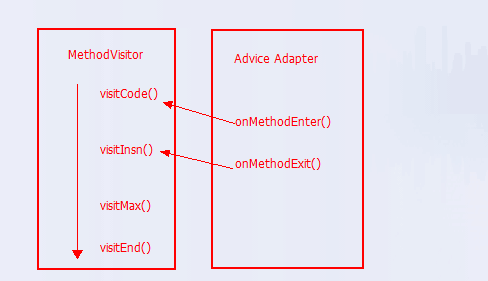对于 AdviceAdapter 类来说,能够很容易的实现在“方法进入”和“方法退出”时添加代码。
AdviceAdapter 类的特点:引入了 onMethodEnter() 方法和 onMethodExit() 方法。
┌─── onMethodEnter()
AdviceAdapter ───┤
└─── onMethodExit()
AdviceAdapter 类
class info
第一个部分,AdviceAdapter 类是一个抽象的(abstract)、特殊的 MethodVisitor 类。
具体来说,AdviceAdapter 类继承自 GeneratorAdapter 类,而 GeneratorAdapter 类继承自 LocalVariablesSorter 类,
LocalVariablesSorter 类继承自 MethodVisitor 类。
- org.objectweb.asm.MethodVisitor
- org.objectweb.asm.commons.LocalVariablesSorter
- org.objectweb.asm.commons.GeneratorAdapter
- org.objectweb.asm.commons.AdviceAdapter
- org.objectweb.asm.commons.GeneratorAdapter
- org.objectweb.asm.commons.LocalVariablesSorter
由于 AdviceAdapter 类是抽象类(abstract),如果我们想使用这个类,那么就需要实现一个具体的子类。
public abstract class AdviceAdapter extends GeneratorAdapter implements Opcodes {
}
fields
第二个部分,AdviceAdapter 类定义的字段有哪些。其中, isConstructor 字段是判断当前方法是不是构造方法。如果当前方法是构造方法,在“方法进入”时添加代码,需要特殊处理。
public abstract class AdviceAdapter extends GeneratorAdapter implements Opcodes {
protected int methodAccess;
protected String methodDesc;
private final boolean isConstructor;
}
constructors
第三个部分,AdviceAdapter 类定义的构造方法有哪些。
需要注意的是,AdviceAdapter 的构造方法是用 protected 修饰,因此这个构造方法只能在子类当中访问。
换句话说,在外界不能用 new 关键字来创建对象。
public abstract class AdviceAdapter extends GeneratorAdapter implements Opcodes {
protected AdviceAdapter(final int api, final MethodVisitor methodVisitor,
final int access, final String name, final String descriptor) {
super(api, methodVisitor, access, name, descriptor);
methodAccess = access;
methodDesc = descriptor;
isConstructor = "<init>".equals(name);
}
}
methods
第四个部分,AdviceAdapter 类定义的方法有哪些。
在 AdviceAdapter 类的方法中,定义了两个重要的方法:onMethodEnter() 方法和 onMethodExit() 方法。
public abstract class AdviceAdapter extends GeneratorAdapter implements Opcodes {
// Generates the "before" advice for the visited method.
// The default implementation of this method does nothing.
// Subclasses can use or change all the local variables, but should not change state of the stack.
// This method is called at the beginning of the method or
// after super class constructor has been called (in constructors).
protected void onMethodEnter() {}
// Generates the "after" advice for the visited method.
// The default implementation of this method does nothing.
// Subclasses can use or change all the local variables, but should not change state of the stack.
// This method is called at the end of the method, just before return and athrow instructions.
// The top element on the stack contains the return value or the exception instance.
protected void onMethodExit(final int opcode) {}
}
对于 onMethodEnter() 和 onMethodExit() 这两个方法,我们从三个角度来把握它们:
- 第一个角度,应用场景。
onMethodEnter()方法:在“方法进入”的时候,添加一些代码逻辑。onMethodExit()方法:在“方法退出”的时候,添加一些代码逻辑。
- 第二个角度,注意事项。
- 第一点,对于
onMethodEnter()和onMethodExit()这两个方法,都要注意 Subclasses can use or change all the local variables, but should not change state of the stack。也就是说,要保持 operand stack 在修改前和修改后是一致的。 - 第二点,对于
onMethodExit()方法,要注意 The top element on the stack contains the return value or the exception instance。也就是说,“方法退出”的时候,operand stack 上有返回值或异常对象,不要忘记处理,不要弄丢了它们。
- 第一点,对于
- 第三个角度,工作原理。
- 对于
onMethodEnter()方法,它是借助于visitCode()方法来实现的。使用onMethodEnter()方法的优势在于,它能够处理<init>()的复杂情况,而直接使用visitCode()方法则可能导致<init>()方法出现错误。 - 对于
onMethodExit()方法,它是借助于visitInsn(int opcode)方法来实现的。
- 对于
示例:打印方法参数和返回值
预期目标
假如有一个 HelloWorld 类,代码如下:
public class HelloWorld {
private String name;
private int age;
public HelloWorld(String name, int age) {
this.name = name;
this.age = age;
}
public void test(long idCard, Object obj) {
int hashCode = 0;
hashCode += name.hashCode();
hashCode += age;
hashCode += (int) (idCard % Integer.MAX_VALUE);
hashCode += obj.hashCode();
hashCode = Math.abs(hashCode);
System.out.println("Hash Code is " + hashCode);
if (hashCode % 2 == 1) {
throw new RuntimeException("illegal");
}
}
}
我们想实现的预期目标:打印出构造方法(<init>())和 test() 的参数和返回值。
编码实现
import java.text.SimpleDateFormat;
import java.util.Arrays;
import java.util.Date;
public class ParameterUtils {
private static final ThreadLocal<SimpleDateFormat> formatter = ThreadLocal.withInitial(
() -> new SimpleDateFormat("yyyy-MM-dd HH:mm:ss")
);
public static void printValueOnStack(Object value) {
if (value == null) {
System.out.println(" " + value);
}
else if (value instanceof String) {
System.out.println(" " + value);
}
else if (value instanceof Date) {
System.out.println(" " + formatter.get().format(value));
}
else if (value instanceof char[]) {
System.out.println(" " + Arrays.toString((char[])value));
}
else {
System.out.println(" " + value.getClass() + ": " + value.toString());
}
}
public static void printText(String str) {
System.out.println(str);
}
}
import org.objectweb.asm.ClassVisitor;
import org.objectweb.asm.MethodVisitor;
import org.objectweb.asm.Type;
import org.objectweb.asm.commons.AdviceAdapter;
import static org.objectweb.asm.Opcodes.*;
public class ClassPrintParameterVisitor extends ClassVisitor {
public ClassPrintParameterVisitor(int api, ClassVisitor classVisitor) {
super(api, classVisitor);
}
@Override
public MethodVisitor visitMethod(int access, String name, String descriptor, String signature, String[] exceptions) {
MethodVisitor mv = super.visitMethod(access, name, descriptor, signature, exceptions);
if (mv != null) {
boolean isAbstractMethod = (access & ACC_ABSTRACT) != 0;
boolean isNativeMethod = (access & ACC_NATIVE) != 0;
if (!isAbstractMethod && !isNativeMethod) {
mv = new MethodPrintParameterAdapter(api, mv, access, name, descriptor);
}
}
return mv;
}
public static class MethodPrintParameterAdapter extends AdviceAdapter {
public MethodPrintParameterAdapter(int api, MethodVisitor mv, int access, String name, String descriptor) {
super(api, mv, access, name, descriptor);
}
@Override
protected void onMethodEnter() {
printMessage("Method Enter: " + getName() + methodDesc);
Type[] argumentTypes = getArgumentTypes();
for (int i = 0; i < argumentTypes.length; i++) {
Type t = argumentTypes[i];
loadArg(i);
box(t);
printValueOnStack("(Ljava/lang/Object;)V");
}
}
@Override
protected void onMethodExit(int opcode) {
printMessage("Method Exit: " + getName() + methodDesc);
if (opcode == ATHROW) {
super.visitLdcInsn("abnormal return");
}
else if (opcode == RETURN) {
super.visitLdcInsn("return void");
}
else if (opcode == ARETURN) {
dup();
}
else {
if (opcode == LRETURN || opcode == DRETURN) {
dup2();
}
else {
dup();
}
box(getReturnType());
}
printValueOnStack("(Ljava/lang/Object;)V");
}
private void printMessage(String str) {
super.visitLdcInsn(str);
super.visitMethodInsn(INVOKESTATIC, "sample/ParameterUtils", "printText", "(Ljava/lang/String;)V", false);
}
private void printValueOnStack(String descriptor) {
super.visitMethodInsn(INVOKESTATIC, "sample/ParameterUtils", "printValueOnStack", descriptor, false);
}
}
}
进行转换
import lsieun.utils.FileUtils;
import org.objectweb.asm.ClassReader;
import org.objectweb.asm.ClassVisitor;
import org.objectweb.asm.ClassWriter;
import org.objectweb.asm.Opcodes;
public class HelloWorldTransformCore {
public static void main(String[] args) {
String relative_path = "sample/HelloWorld.class";
String filepath = FileUtils.getFilePath(relative_path);
byte[] bytes1 = FileUtils.readBytes(filepath);
//(1)构建 ClassReader
ClassReader cr = new ClassReader(bytes1);
//(2)构建 ClassWriter
ClassWriter cw = new ClassWriter(ClassWriter.COMPUTE_FRAMES);
//(3)串连 ClassVisitor
int api = Opcodes.ASM9;
ClassVisitor cv = new ClassPrintParameterVisitor(api, cw);
//(4)结合 ClassReader 和 ClassVisitor
int parsingOptions = ClassReader.SKIP_DEBUG | ClassReader.SKIP_FRAMES;
cr.accept(cv, parsingOptions);
//(5)生成 byte[]
byte[] bytes2 = cw.toByteArray();
FileUtils.writeBytes(filepath, bytes2);
}
}
验证结果
import java.util.Date;
public class HelloWorldRun {
public static void main(String[] args) {
HelloWorld instance = new HelloWorld("tomcat", 10);
instance.test(441622197605122816L, new Date());
}
}
AdviceAdapter VS. MethodVisitor
AdviceAdapter 类的特点:引入了 onMethodEnter() 方法和 onMethodExit() 方法。
┌─── onMethodEnter()
AdviceAdapter ───┤
└─── onMethodExit()
同时,回顾一下 MethodVisitor 类里的四个主要方法:
┌─── visitCode()
│
├─── visitXxxInsn()
MethodVisitor ───┤
├─── visitMaxs()
│
└─── visitEnd()
将 AdviceAdapter 类和 MethodVisitor 类进行一下对比:
AdviceAdapter.onMethodEnter()方法对应着MethodVisitor.visitCode()方法AdviceAdapter.onMethodExit()方法对应着MethodVisitor.visitInsn(opcode)方法当中 opcode 为return或athrow的情况

总结
本文对 AdviceAdapter 类进行介绍,内容总结如下:
- 第一点,在
AdviceAdapter类当中,有两个关键的方法,即onMethodEnter()和onMethodExit()方法。我们可以从三个角度来把握这两个方法:- 从使用场景的角度来说,
AdviceAdapter类能够很容易的在“方法进入”时和“方法退出”时添加一些代码。 - 从注意事项的角度来说, Subclasses can use or change all the local variables, but should not change state of the stack.
- 从工作原理的角度来说,
onMethodEnter()方法是借助于visitCode()方法来实现的;onMethodExit()方法是借助于visitInsn(int opcode)方法来实现的。
- 从使用场景的角度来说,
- 第二点,特殊的情况的处理。
- 有些时候,使用
AdviceAdapter类的onMethodEnter()和onMethodExit()方法是不能正常工作的。比如说,一些代码经过混淆(obfuscate)之后,ByteCode 的内容就会变得复杂,就会出现处理不了的情况。这个时候,我们还是应该回归到visitCode()和visitInsn(opcode)方法来解决问题。
- 有些时候,使用
